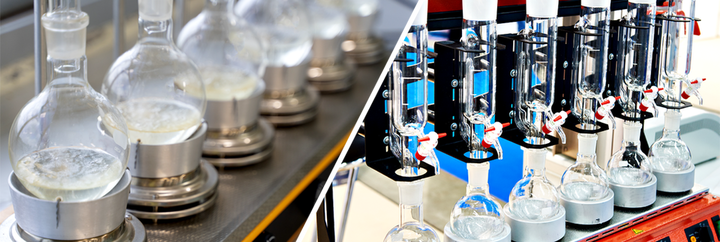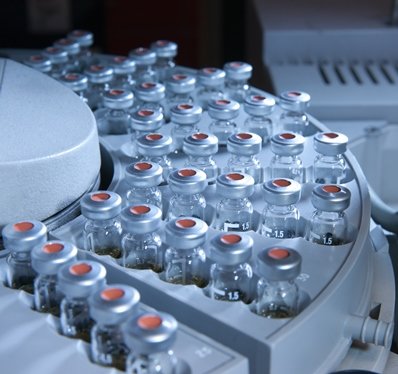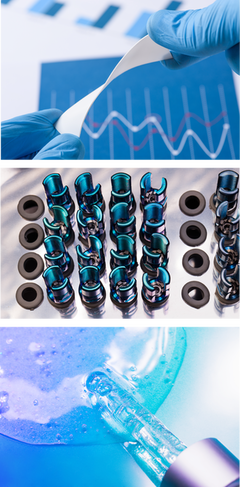Providing Quality Chemical Characterization So You Can Improve Quality of Life

How Safe Is My Device?
Accurate extractables analysis of medical devices, coupled with toxicological risk assessment, can save time, money, and minimize risk when bringing your product to market. However, recent changes in ISO 10993-18:2020 have made conducting a chemical risk assessment even more challenging than ever before.
When Do I Need a Chemical Risk Assessment?
According to ISO 10993-1:2018, chemical risk assessment is the first step in performing a biocompatibility assessment.
As part of FDA submissions such as Investigational Device Exemption (IDE), 510(K) Premarket Notification, Premarket Approval (PMA).
The EU MDR has similar requirements for chemical risk assessment.
To evaluate a new material of composition or contact material as being chemically equivalent to an “old” material.
As a guideline for internal Quality Control.
What If My Device Is Made of Biomedical Grade Materials?
It is true that the use of USP Class VI, ISO 5832, or FDA Master File Materials can reduce the risk of potentially toxic extractables. However, such designations are usually associated with the raw material, which may be transformed or change in composition during the process of converting to the final finished form.
Therefore, the use of a “biomedical” grade material is generally not sufficient justification to avoid chemical characterization or extractable testing. Additionally, if your device is a long-term implant, ISO 10993-18:2020 requires exhaustive extraction.
What If My Device Has Metallic Components?
For a metallic device, the question of chemical composition may seem straightforward: is it simply the alloy the device is machined or otherwise manufactured from? Unfortunately, considering only the base alloy does not take into account the processing aids which are used in the manufacture of the device and which may be left behind as residues on the surface of the part.
These residues may include polishing compounds, lubricants, machine oils, cleaning agents, or adhesive residue from tape used to 'mask off' regions of the device. Inorganic residues (particulates, ions, elemental impurities, etc.) that may be released should also be considered separately from the base material. An additional factor to consider is if the component has highly porous regions (e.g. to facilitate osseointegration) which may make the device more difficult to clean and in which manufacturing residues may linger. Finally, if your metallic device is a long-term implant, exhaustive extraction is required.
What If My Device Is a Short-Term Implant?
If the chemical composition of the device (both the raw materials as well as any manufacturing residues) are unknown or have not been previously characterized, an extractables assessment is typically necessary to determine the composition. Unless the device manufacturer has previous experience characterizing the material/manufacturing process by extractables, sufficient information on the device composition (including impurities, manufacturing residues, etc.) is generally not available for this to be a pure paper exercise.
Note that from an analytical perspective, given the short-term nature of the device, the analytical evaluation threshold (AET) employed will be less stringent than for a long-term implant. This means that when evaluating extractables data from techniques like GC-MS, and LC-MS, the number of peaks which must be identified and submitted for toxicological risk assessment is significantly lower than for a permanent implant--translating to generally lower cost and faster turnarounds.
Step 1: Made explicit in ISO 10993-18:2020, the critical first step of the chemical risk assessment is information gathering. This involves collecting all available data on the medical device’s materials of construction, additive packages, surface treatments/coatings, etc. In addition to information on the compositional level, the information gathering step also includes collection of the manufacturing processing aids and processing conditions: e.g. machine oils, spin finishes, polishing compounds, sterilization modes, etc.
Essentially, the practitioner should consider anything that may be left behind on the device as a residue and result in subsequent patient exposure. In practice, the information gathering step is often challenging to thoroughly complete due to the use of proprietary mixtures/formulations in the device or its manufacturing process. Such information gathering efforts provide a baseline level of information that may be able to justify whether additional chemical characterization testing (extractables) is necessary. Furthermore, the information provides critical context for guiding analytical method selection, reference/surrogate standards employment, and is an invaluable aid in compound identification.
Step 2: For devices of greater risk or more uncertainty in materials/manufacturing, an extractable study is likely to be required, at minimum. Such extractable studies generally aim to remove either more chemical species than would be expected to leave the device under anticipated clinical conditions (exaggerated extraction), or aim to remove all chemical species that could conceivably be removed from the device (exhaustive extraction). For permanent implant devices, exhaustive extraction is performed.
Compounds identified through these extractions are first considered through a ‘worst case’ lens—e.g. the device suddenly dissolving and all potential extractables are released in a single bolus.
If the results of this extractable study and conservative risk assessment flag compounds at concentrations that present a potential toxicological concern, leachable studies may be necessary to more accurately estimate the actual patient exposure to these species under simulated clinical use conditions.
Step 3: After the extractable testing is complete, identified compounds and their concentrations are submitted for a toxicological risk assessment, generally by ISO 10993-17 (this process should be performed by a certified toxicologist). A key output of this assessment includes margin of safety (MoS) values for each chemical, however the process of evaluating the results should also consider if individual chemicals are “expected” and “unexpected’’ based on the device materials and manufacturing process, as well as evaluating variability between samples or manufacturing lots.
If some chemicals are found to present a potential toxicological risk (i.e. MoS near or less than 1), a targeted leachable study may be necessary in order to evaluate the actual concentration of the compound when the device is subjected to simulated end use conditions. Only compounds flagged as potentially above toxicological threshold need be evaluated in the leachable study.
AET- How Low Do I Go?
The AET answers the critical questions of:
1. How sensitive does the analytical method have to be?
2. Of all the peaks detected in a sample extract, which must be identified and undergo toxicological risk assessment?
The AET is not a single value for a compound—it is calculated (see Annex E of ISO 10993-18:2020) on the basis of a toxicological threshold and depends on the nature of the patient contact, the frequency and duration of the device‘s use, the number of devices that may be simultaneously implanted, and the specific extraction conditions employed in the chemical characterization study (accounting for dilutions etc.).
The AET prevents analysts from getting buried in the weeds; identifying and assessing compounds that could not pose a toxicological risk. It also ensures that the practitioner has confidence in the suitability of the analytical method sensitivity at the outset—mitigating the possibility of finding out months later that potentially hazardous constituents were buried in the baseline noise, requiring costly retests and delays.
Cambridge Polymer Group works closely with our toxicology partner, who prepares a toxicological risk assessment report using CPG’s chemical characterization data.
How Do I Comply with ISO 10993-18:2020?
Given the dramatic changes and changing regulatory landscape, medical device manufacturers are encouraged to review the standards carefully, consult with expert practitioners, and where possible present a detailed experimental protocol to the FDA ahead of time.

Why Choose Cambridge Polymer Group for Your Chemical Risk Assessment?
Cambridge Polymer Group scientists recognize that chemical characterization is not a once-size-fits-all approach and does not usually lend itself to turn-key solutions. Every medical device represents a unique combination of materials, manufacturing steps, and end use conditions. Each must be fully considered to provide adequate justification for analytical method selection and crucial context for confidence in extractable identifications.
In addition to leveraging our state-of-the-art lab instrumentation and deep knowledge of polymer science, CPG scientists work closely with you to ensure that your workflow is grounded in the context of your product. CPG's successful track record with medical device extractables and leachables enables us to avoid the typical pitfalls of chemical characterization projects, such as:
non-compliance with most current regulatory guidance
incomplete analytical methods
unclear confidence in identification
unknown extractables
inaccurate measurements of extractable concentrations
If you usually perform extractables and leachables testing in-house but no longer have the resources to meet your testing volume or the new regulatory standard, Cambridge Polymer Group can provide E&L testing on an as-needed basis. If your company is a start-up or small business, working with CPG allows access to the testing and expertise essential to bringing your device to market, without an investment in expensive instruments or new hires.

Please contact us for more information on how we can assist in evaluating your devices to the new ISO 10993-18:2020 standard and workflows.


